The Microsoft Surface Pro (2017) Review: Evolution
by Brett Howse on June 15, 2017 9:00 AM ESTSystem Performance
The Surface Pro has always provided good performance for the size of the device, and for the new Surface Pro, we see the step to the latest 7th generation Intel Core processors. The choices are the same as the outgoing Pro 4, but one generation newer. Even though the latest Kaby Lake chips utilize the same CPU architecture as Skylake, improvements to the 14 nm process, which Intel is calling 14nm+ allows for higher frequencies, and lower power consumption, so despite having the same architecture, there are gains to be had. Let’s take a look at the CPUs.
| Surface Pro 4 CPU vs Surface Pro (2017) CPU | |||
| CPU | Core m3 | Core i5 | Core i7 |
| Surface Pro 4 | Core m3-6Y30 2 core, 4 thread 900 MHz to 2.2 GHz |
Core i5-6300U 2 core, 4 thread 2.4 GHz to 3.0 GHz |
Core i7-6660U 2 core, 4 thread 2.4 GHz to 3.4 GHz |
| Surface Pro (2017) | Core m3-7Y30 2 core, 4 thread 1.0 GHz to 2.6 GHz |
Core i5-7300U 2 core, 4 thread 2.6 GHz to 3.5 GHz |
Core i7-7660U 2 core, 4 thread 2.5 GHz to 4.0 GHz |
| Increase | 100 MHz (base) 400 MHz (turbo) | 200 MHz (base) 500 MHz (turbo) | 100 MHz (base) 600 MHz (turbo) |
You can see the base frequencies have all improved slightly, but the boost frequencies on all of the chips have increased significantly. This will allow quite a bit more responsiveness from the system, as well as overall higher performance if the device can keep the heat and power consumption in check for more sustained boosting.
Microsoft has provided the Core i7-7660U Surface Pro for review, with 16 GB of RAM and a 512 GB SSD. This adds another wrinkle over most other Ultrabooks in that it offers the Intel Iris Plus Graphics 640, compared to the HD 620 graphics in the i5 (and most other Ultrabooks) and the HD 615 graphics with the Core m3 model. The Iris Plus graphics configuration not only doubles the execution units available, from 24 to 48, but also includes 64 MB of eDRAM which can be used as a system cache as well as a graphics buffer. This provides yet another tier of memory before having to go to the (relatively) slow system memory, and depending on the application, can provide a real boost to performance.
Speaking of the integrated GPU, besides clockspeeds, this is the other area where the switch to Intel's Kaby Lake processors improves things for the Surface Pro. The GPU's media block received a significant overhaul, getting full hardware support for HEVC Main10 and the VP9 codec. The former is going to be popular with commercial streaming services over the long haul, and the latter is Google's codec of choice for YouTube, which immediately unlocks a good deal of power savings. Furthermore Kaby Lake is the first Intel processor family to get Netflix 4K support, offering a level of detail more befitting of the Surface Pro's higher resolution (though not quite 4K) display.
It's no surprise then that Microsoft has opted to keep the fan on the Core i7 model, since the extra graphics can quickly eat up the available TDP, but we did clarify with them that the Core i5 model is still running at the full 15-Watt TDP of the i5-7300U, and hasn't been intentionally set to a lower TDP via cTDP functionality. Hopefully we’ll have a chance to test that at a later date and see how the lack of active cooling impacts it.
Speaking of cooling, the Surface Pro now includes a slider if you click on the battery icon, which allows you to quickly and easily change the power mode. The choices are Best Battery Life, Better Performance, and Best Performance, with Best Battery Life as the default and recommended. Modern Standby devices have not allowed you to adjust the power settings very much before, so it’s nice to see some choices here now. Microsoft let us know that the slider settings adjust CPU efficiency and the PL1 / PL2 settings. In “battery saver” the CPU and GPU are throttled with priority given to the GPU. In “best performance” the CPU and GPU run at full power. This makes a big difference on noise levels, but also impacts performance, and we’ll dig into that when we look at the cooling later on. For the following scores, Best Performance was chosen for all of the graphs.
We’ve tested the Surface Pro with our standard laptop test suite, and comparisons will be among other similar devices. The Surface Pro 4 in the graph was the Core i5-6300U model, and since we didn’t get to test anything with Core i7-6660U, the Surface Book will be used as a comparison with the Core i7-6600U (although it did have external graphics as well). For other comparisons, there are some more Ultrabooks, and the Dell XPS 15 with quad-core 45-Watt Skylake to give a comparison against a larger device.
PCMark
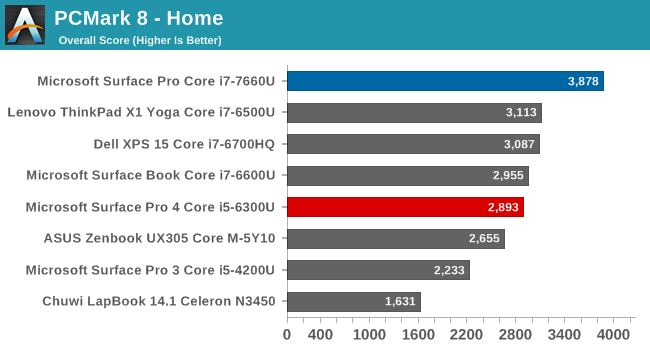
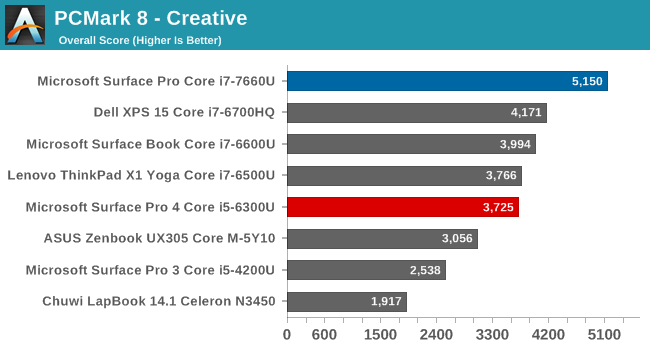
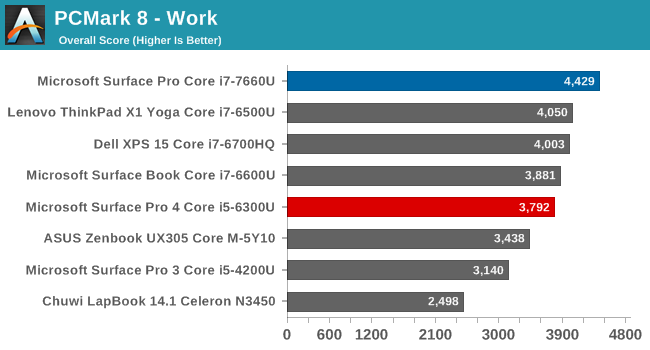
PCMark has just launched an updated version of their all-in-one PC test, and once we have some more data from it, you should start to see it appear in our reviews. For now, since we have a lot of existing data on PCMark 8, we’ll showcase that. PCMark really tries to be a real-world test, with many different workloads that range from short, bursty tests, to longer sustained 3D gaming. As you can see, the Surface Pro is a significant step ahead of every other system here, with the combination of a higher frequency CPU, 64 MB of eDRAM, and double the execution units in the GPU of most other devices. Both Home and Creative see the largest gains, since they both have some gaming involved, but even the Work scores are a good step above the rest of the devices, including the quad-core Dell XPS 15.
Cinebench

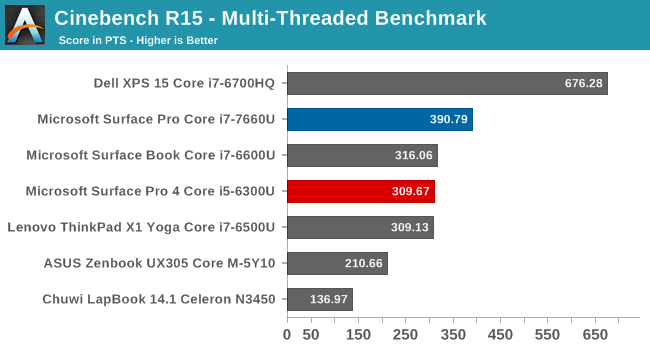
Cinebench is a rendering test, and we showcase the CPU scores only. It allows both single-threaded and multi-threaded versions of the test, and since it’s mostly CPU based, it’s a great display of the progress in CPU performance gains. You can see that the 15 W Core i7-7660U in the Surface Pro easily beats everything in the single-threaded version of this test, but the quad-core Dell XPS 15 unsurprisingly dominates on multi-threaded testing.
x264
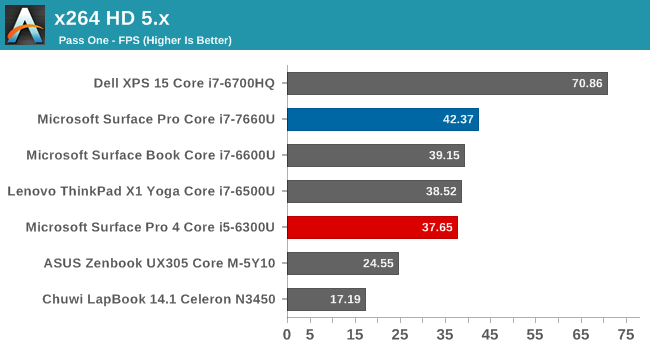

Much like Cinebench, x264 is mostly a CPU test, and a video clip is converted on the CPU into h264. There is no single-threaded option though, so you can see the quad-core parts still offer a lot more grunt for these kinds of tasks, but compared to the other Ultrabooks, the Surface Pro is the fastest again.
Web Tests
Browsing performance is tough to capture well, mostly because the results are so heavily impacted by the browser. Browsers continue to improve on scripting performance, so over time, even the same system will improve somewhat. Still, it’s important to look at since so much of our time is spent on the web. Google Octane is now deprecated, and we’ll phase it out soon, but since we have a large sample of older devices tested, it’s still a good test to check out.
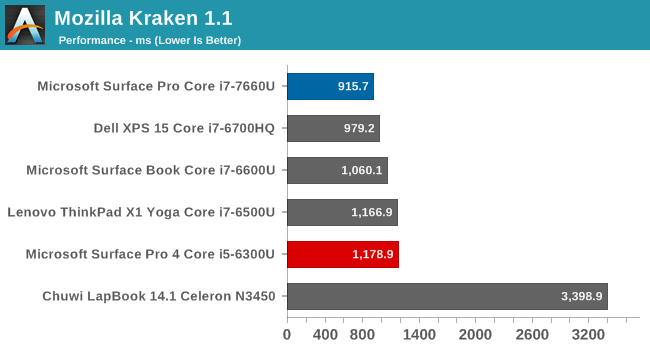
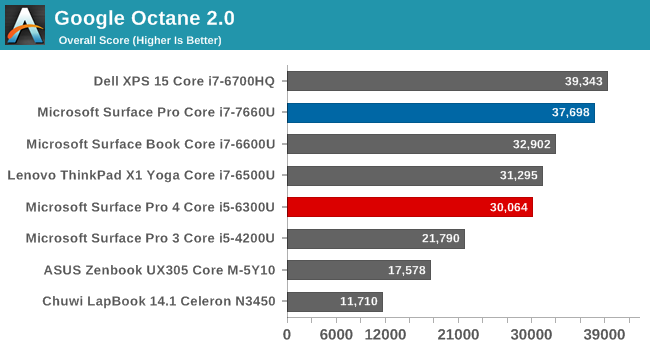
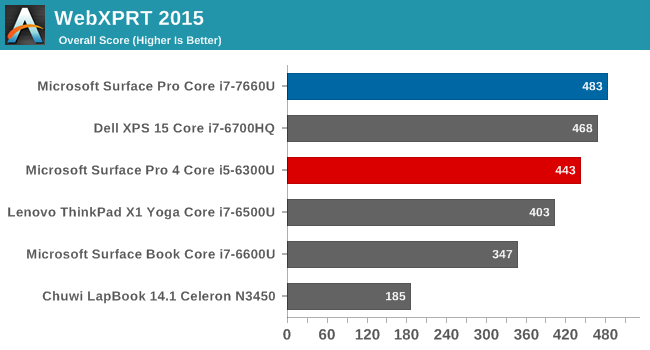
The combination of the latest Edge browser in the Creators Update version of Windows 10, with the speedy Core i7-7660U, put the Surface Pro pretty much at the top of all of these results.
System Performance Conclusion
The amount of performance that’s able to be packed inside of such a small device continues to impress, and for the first time, we’ve been able to check out the Core i7 model with Intel Iris graphics. Surface Pro can easily hold its own against any other Ultrabook, and often surpass it in performance. It would be great to see more vendors offering Intel's Iris graphics, since there are only a handful at the moment. But regardless, the move from Skylake to Kaby Lake has been a nice step forward, despite the CPU architecture remaining the same.


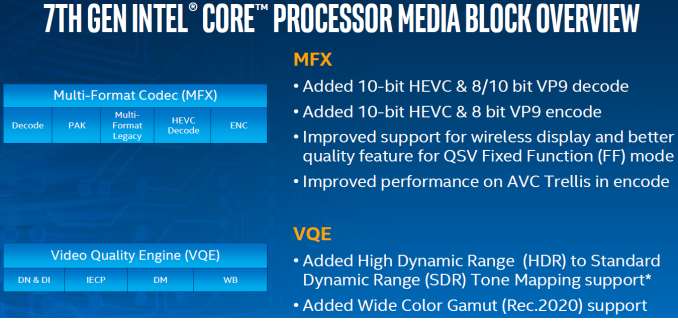








124 Comments
View All Comments
mkozakewich - Saturday, June 17, 2017 - link
I swear I say this every time, but it bears repeating: One of the original ideas about ultrabooks was that we could throttle them while mobile, but then run them at full power by using some kind of cooling dock. Same thing here: If you had (or made?) something that cools off the chassis, it'll reach higher performance levels. Using it outside on a cold and windy day will give you more frames per second. Stuff like that.tipoo - Monday, June 19, 2017 - link
Yup, very interested about the fanless 15W i5 and how well that can keep up. In theory it would act pretty Core M-ey.anactoraaron - Thursday, June 15, 2017 - link
I remember owning a pro 4 and being disappointed learning that the review samples used a faster ssd. All retail units had much slower ssds and a ridiculous amount of light bleed on the displays. I had one at launch (and returned a few to try and get less light bleed and perhaps the faster ssd used by the review units) but the first time I got a blue screen negating over an hour of work it had to go. It was a great concept, as I ultimately went with the Vaio Z Canvas (during the fire sale). The Vaio has been by far the better option, with plenty of ports and power (not to mention it also has a better display) to its advantage over the surface pro.SaolDan - Thursday, June 15, 2017 - link
I actually owned a sp4 i5 with the toshiba ssd and it had faster write. about 1GBps write speed. But tbe screen developed a small preasure point and i got it replaced. I got a samsung ssd on the replacement. not as fast.samnish - Thursday, June 15, 2017 - link
As an owner of Surface Pro 2 and 4, I must say, I went from loving the idea to hating the series. To list a few issues:- Normal sleep mode never works. Either it wakes up to a black screen, or it used up all the battery while sleeping. It is pretty much required to disable sleep and use hibernation instead.
- The Wacom pen on SP2 worked well. The one on the SP4 is a huge step downwards. If you want to draw a straight line, you need to draw it by the edge of the screen, because when you draw in the middle of the screen it'd give you a squigly line. Happaned even after exchanging for another one at MS store.
- On the SP4, I encountered a bug where a process "Microsoft IME" would hog up 100% of the CPU. If memory serves, it was introduced by the Anniversary Update. After a lengthy thread on Microsoft forum with many other victims, MS did fix it. But it took them 3 months.
- When charging, if the SP4 is grounded slightly different than myself, the touchpad would have an jittery response. I have to touch the chassis of the SP4 with my other hand to make the touchpad work normally. Happaned even after exchanging for another one at MS store.
This is enough examples. The Surface Pro series was Microsoft's poster child, yet they couldn't even get all the basic laptop features working stably for 4 generations. With laptops from other manufacturers, one can defend MS by saying "they have many different hardware to support, drivers take time to mature". Sure. What about the Surface Pro series? You can't really defend them with the same points - all the hardware is chosen and supported by Microsoft themselves. By Surface Pro 4, they really shouldn't still be struggling with delivering firmware that don't break your hardware and a sleep mode that works. I hope the new Surface Pro fares better this time on these departments, but I don't have high hopes for them. Microsoft has a much stronger showing for innovation in recent years, yet the hardware that they deliver are full of small glitches, and the stability of their consumer operating system has been such a mess.
mkozakewich - Saturday, June 17, 2017 - link
I had a lot of problems with the little things. When I close my cover, the touchpad starts activating the screen, causing it to wake from sleep or start dragging icons around. I'm actually having a more consistent time with my $400 Chuwi. It feels weirdly magical to be able to close it without worrying about it waking up again.tipoo - Thursday, June 15, 2017 - link
Pretty curious about that 15W fanless middle tier. I'm assuming it would act pretty Core M-ey, but I wonder if it would do worse than silicon selected for the lower TDP, or if the chips are pretty much the same with different TDP-Downs.id4andrei - Thursday, June 15, 2017 - link
The Core M SP4 had great cooling. As long as the fanless i5 throttles at about the same threshold as ultrabooks with fans it would be a success.KPOM - Sunday, June 18, 2017 - link
The 15w cpus can downvolt to 7W. I wounded if that is what Microsoft is doing with the i5.tipoo - Monday, June 19, 2017 - link
Yeah that's what I meant about the TDP-Down, in theory a 15W chip with a tdp-down to 7W and a 5W chip with a TDP-up to 7W would act the same as the silicon is the same.